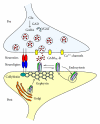Alterations of GABAergic signaling in autism spectrum disorders
- PMID: 21766041
- PMCID: PMC3134996
- DOI: 10.1155/2011/297153
Alterations of GABAergic signaling in autism spectrum disorders
Abstract
Autism spectrum disorders (ASDs) comprise a heterogeneous group of pathological conditions, mainly of genetic origin, characterized by stereotyped behavior, marked impairment in verbal and nonverbal communication, social skills, and cognition. Interestingly, in a small number of cases, ASDs are associated with single mutations in genes encoding for neuroligin-neurexin families. These are adhesion molecules which, by regulating transsynaptic signaling, contribute to maintain a proper excitatory/inhibitory (E/I) balance at the network level. Furthermore, GABA, the main inhibitory neurotransmitter in adult life, at late embryonic/early postnatal stages has been shown to depolarize and excite targeted cell through an outwardly directed flux of chloride. The depolarizing action of GABA and associated calcium influx regulate a variety of developmental processes from cell migration and differentiation to synapse formation. Here, we summarize recent data concerning the functional role of GABA in building up and refining neuronal circuits early in development and the molecular mechanisms regulating the E/I balance. A dysfunction of the GABAergic signaling early in development leads to a severe E/I unbalance in neuronal circuits, a condition that may account for some of the behavioral deficits observed in ASD patients.
Figures



References
-
- American Psychiatric Association. Diagnostic and Statistical Manual of Mental Disorders (DMS-IV-TR) Washington, DC, USA: American Psychiatric Association; 2000.
-
- Garber K. Autism’s cause may reside in abnormalities at the synapse. Science. 2007;317(5835):190–191. - PubMed
-
- Geschwind DH, Levitt P. Autism spectrum disorders: developmental disconnection syndromes. Current Opinion in Neurobiology. 2007;17(1):103–111. - PubMed
Publication types
MeSH terms
Substances
LinkOut - more resources
Full Text Sources
Medical

